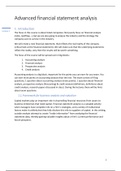Summary
Summary Notities Advanced Financial Statement Analysis les 1-8
- Course
- Institution
This document contains the notes and slides of the course Advanced Financial Statement Analysis from the academic year given by Professor Heidi Vander Bauwhede. All examples of the lesson are also in the summary. Here and there additional information was added from the book if this was not clear f...
[Show more]




